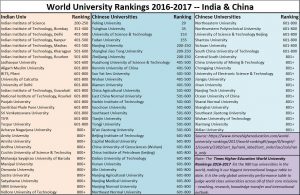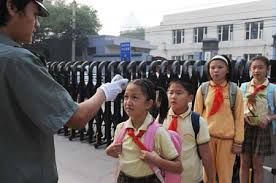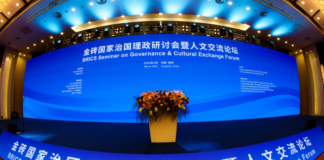Policy Watch
India slips on education: The Times Higher Education World University rankings
Rn bhaskar
Last week, The Times Higher Education World brought out its university rankings for 2016-2017. This is a list that all aspiring universities of the world watch, because it tells students which University is among the best. This list covered 980 top universities in the world.
 Only 31 Indian educational institutions managed to secure a place on this list. Neighbouring China did much better. It saw 51 of its educational institutes get listed here.
Only 31 Indian educational institutions managed to secure a place on this list. Neighbouring China did much better. It saw 51 of its educational institutes get listed here.
But the shame goes deeper. There was a time when the IITs secured a place among the top 100. Today, they rank below 351. And their rankings continue to slip.
In sharp contrast, look at China. Even though it began its pursuit of colleges of excellence much after India did, today it boasts of better and numerically larger number of excellent educational institutions. More significantly, Chinese institutes manage to improve their rankings year after year.
Watch the list (a fuller list can be viewed in the web-version). Unlike India, the list features an entire spectrum of educational institutes: polytechnics, medicine, oceanography, petrochemicals, mining and agriculture. There are several reasons why China has continued to excel, while India has continued to fall in rankings.
First, China pursues excellence in a more focused manner than does India. It hires the best teachers in the world, pays them fees comparable with the best institutes worldwide. It measures incentives based on (a) national requirement, and (b) outcomes. India has not followed such policies.
Second, China ensures that the quality of students that gain admission to its higher education centres is extremely high. It ensures this through two measures:
- It focuses on quality school education (http://www.asiaconverge.com/2016/04/lessons-education-china-india/). And it boasts of 95% literacy. After all, no college can be expected to upgrade students who have had 10-12 years of rotten school education. India has seen its school education crumble. The inability of its government to create enough jobs also encourages students in India to seek higher education as a ‘filler’ till a suitable employment opportunity turns up. If such vacancies don’t turn up, the student begins to look for a job only after graduation, thus making him or her overqualified for most jobs. The reality is that India does not suffer from unemployment as much as unemployability (http://www.asiaconverge.com/2015/10/sweeper-graduates-educated-unemployable/). The Indian government thus wastes money on sub-standard education.
- China ensures that only the best get admission to higher education. The rest must go in for specialized skill-based courses, or move into the employment stream. There is no dilution of admission standards in the name of reservation, or domicile.
- China ensures that its fees remain low, so that high fees do not stoke expectations of a high starting salary. For instance, even the most reputed medical institute will offer a full medical course for becoming a doctor at reasonable costs. A five-year course, with residence, could cost a student Rs.12-14 lakh. In India, just capitation fees stand at Rs.1 crore (without the guarantee of good facilities or even teachers).
If India has to climb educational rankings, it must do several things.
First, it must strengthen school education.
Second, it must allow reservation – and if required scholarships and incentives – for backward communities only till the school level. That is where the backward learn to become equal to the best in society. Jobs, and admission to higher learning, must be based strictly on competence, unless the candidate has some other quality in abundant measure to make him qualify for a special exemption. He (or she) must has shown proven excellent in sports, music, performing arts or any other skill to qualify for such exemption. Only then will the nation begin to focus on excellence (http://www.asiaconverge.com/2015/10/make-at-school-to-push-for-make-in-india/).
Third, it must reduce fees for the deserving and meritorious. It could create laws for subsidised fees (say one-tenth of the cost of education) to be paid by only the meritorious. The remaining aspirants (including students from overseas) move to skill-based learning or pay significantly higher fees to cross-subsidise the cost of quality education. Without such legislation, seats for higher education will remain limited, and the costs of education will continue to spiral.
Lastly, leave educational institutes to manage themselves. They can decide the curriculum, the fees (subject to the cross-subsidisation principle). What the government should look for is outcomes. Has the institute trained students well? A national competence examination could determine this. If yes, it should be encouraged to expand. It no, it should be told that if things to not improve the management of the educational institution – along with all its assets – will stand transferred to managements who have done a good job of education (http://www.asiaconverge.com/2015/10/make-at-school-to-push-for-make-in-india/).
It is ironical therefore to hear the education minister speak in two voices. He first stated that the Indian Institutes of Management (IIMs) will be granted autonomy. Immediately thereafter the minister also spoke of reserving teaching posts for backward communities. Someone should tell him that if you compromise on teachers, judges and armed forces, you will have rotten students, poor justice and perhaps no country as well.





































COMMENTS